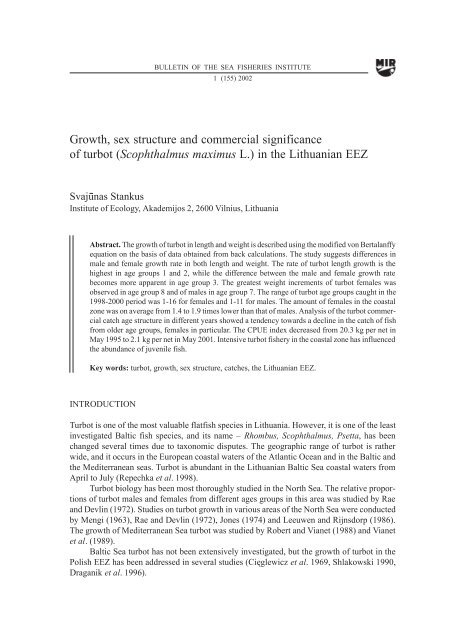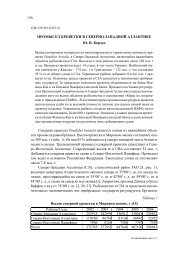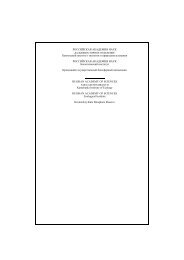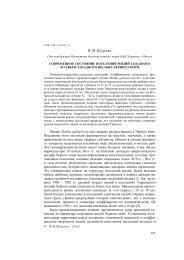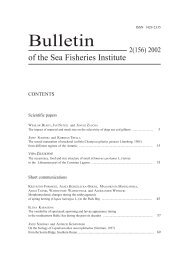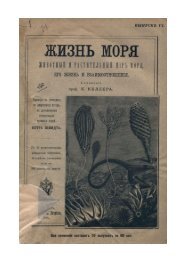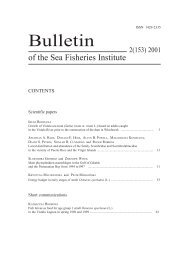Bulletin of the Sea Fisheries Institute 1 (155) 2002 - CEEMaR
Bulletin of the Sea Fisheries Institute 1 (155) 2002 - CEEMaR
Bulletin of the Sea Fisheries Institute 1 (155) 2002 - CEEMaR
You also want an ePaper? Increase the reach of your titles
YUMPU automatically turns print PDFs into web optimized ePapers that Google loves.
BULLETIN OF THE SEA FISHERIES INSTITUTE<br />
1 (<strong>155</strong>) <strong>2002</strong><br />
Growth, sex structure and commercial significance<br />
<strong>of</strong> turbot (Scophthalmus maximus L.) in <strong>the</strong> Lithuanian EEZ<br />
Svajunas Stankus<br />
<strong>Institute</strong> <strong>of</strong> Ecology, Akademijos 2, 2600 Vilnius, Lithuania<br />
Abstract. The growth <strong>of</strong> turbot in length and weight is described using <strong>the</strong> modified von Bertalanffy<br />
equation on <strong>the</strong> basis <strong>of</strong> data obtained from back calculations. The study suggests differences in<br />
male and female growth rate in both length and weight. The rate <strong>of</strong> turbot length growth is <strong>the</strong><br />
highest in age groups 1 and 2, while <strong>the</strong> difference between <strong>the</strong> male and female growth rate<br />
becomes more apparent in age group 3. The greatest weight increments <strong>of</strong> turbot females was<br />
observed in age group 8 and <strong>of</strong> males in age group 7. The range <strong>of</strong> turbot age groups caught in <strong>the</strong><br />
1998-2000 period was 1-16 for females and 1-11 for males. The amount <strong>of</strong> females in <strong>the</strong> coastal<br />
zone was on average from 1.4 to 1.9 times lower than that <strong>of</strong> males. Analysis <strong>of</strong> <strong>the</strong> turbot commercial<br />
catch age structure in different years showed a tendency towards a decline in <strong>the</strong> catch <strong>of</strong> fish<br />
from older age groups, females in particular. The CPUE index decreased from 20.3 kg per net in<br />
May 1995 to 2.1 kg per net in May 2001. Intensive turbot fishery in <strong>the</strong> coastal zone has influenced<br />
<strong>the</strong> abundance <strong>of</strong> juvenile fish.<br />
Key words: turbot, growth, sex structure, catches, <strong>the</strong> Lithuanian EEZ.<br />
INTRODUCTION<br />
Turbot is one <strong>of</strong> <strong>the</strong> most valuable flatfish species in Lithuania. However, it is one <strong>of</strong> <strong>the</strong> least<br />
investigated Baltic fish species, and its name – Rhombus, Scophthalmus, Psetta, has been<br />
changed several times due to taxonomic disputes. The geographic range <strong>of</strong> turbot is ra<strong>the</strong>r<br />
wide, and it occurs in <strong>the</strong> European coastal waters <strong>of</strong> <strong>the</strong> Atlantic Ocean and in <strong>the</strong> Baltic and<br />
<strong>the</strong> Mediterranean seas. Turbot is abundant in <strong>the</strong> Lithuanian Baltic <strong>Sea</strong> coastal waters from<br />
April to July (Repechka et al. 1998).<br />
Turbot biology has been most thoroughly studied in <strong>the</strong> North <strong>Sea</strong>. The relative proportions<br />
<strong>of</strong> turbot males and females from different ages groups in this area was studied by Rae<br />
and Devlin (1972). Studies on turbot growth in various areas <strong>of</strong> <strong>the</strong> North <strong>Sea</strong> were conducted<br />
by Mengi (1963), Rae and Devlin (1972), Jones (1974) and Leeuwen and Rijnsdorp (1986).<br />
The growth <strong>of</strong> Mediterranean <strong>Sea</strong> turbot was studied by Robert and Vianet (1988) and Vianet<br />
et al. (1989).<br />
Baltic <strong>Sea</strong> turbot has not been extensively investigated, but <strong>the</strong> growth <strong>of</strong> turbot in <strong>the</strong><br />
Polish EEZ has been addressed in several studies (Ciêglewicz et al. 1969, Shlakowski 1990,<br />
Draganik et al. 1996).


